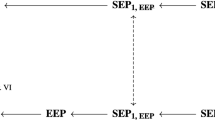Abstract
This paper deals with the concept of simultaneity in classical and relativistic physics as construed in terms of group-invariant equivalence relations. A full examination of Newton, Galilei and Poincaré invariant equivalence relations in ℝ4 is presented, which provides alternative proofs, additions and occasionally corrections of results in the literature, including Malament’s theorem and some of its variants. It is argued that the interpretation of simultaneity as an invariant equivalence relation, although interesting for its own sake, does not cut in the debate concerning the conventionality of simultaneity in special relativity.
Similar content being viewed by others
Notes
This is needed if we wish to build a time coordinate out of simultaneity, as in the approach to the Lorentz transformation adopted by Poincaré and Einstein.
In 1949, as the first of two “insights of definite nature which physics owes to the special theory of relativity”, Einstein stated: “There is no such thing as simultaneity of distant events; […]” ([3], p. 61).
As regards the conventionality issue, I stand by the results and conclusion of [9], although I hope to come back to it, for commentary and extensions, in a future contribution.
Note, however, that to say that G=G 0⋊G 1 does not identify G up to isomorphism, contrary to the case of direct product.
The argument in [4], p. 661, fails to consider the ‘everywhere dense’ case of our Lemma 3.4.
This is Theorem 2 in [6], p. 496, which, however, contains an evident material error in its thesis.
The results of this section form the technical core of the debate on the so-called block-universe concept in special relativity. I will deal with it in a future article.
I.e., the set of all light-like vectors, which does not comprise the zero vector (cf. [13], p. 22).
What amounts essentially to the same criticism has also been made in Grünbaum’s reply ([5], p. 1288).
Compare [10], pp. 1382–1383.
References
Alexandrov, A.D.: Mappings of spaces with families of cones and space-time transformations. Ann. Mat. Pura Appl. 103, 229–257 (1975)
Einstein, A.: Zur elektrodynamik bewegter körper. Ann. Phys. 17, 891–921 (1905)
Einstein, A.: Autobiographical notes (1949), pp. 1–105 of [15]
Giulini, D.: Uniqueness of simultaneity. Br. J. Philos. Sci. 52, 651–670 (2001)
Grünbaum, A.: David Malament and the conventionality of simultaneity: A reply. Found. Phys. 40, 1285–1297 (2010)
Hogarth, M.: Conventionality of simultaneity: Malament’s result revisited. Found. Phys. Lett. 18, 491–497 (2005)
Janis, A.: Conventionality of simultaneity. In: Zalta, E. (ed.) Stanford Encyclopedia of Philosophy (2010), last update: July 15. http://plato.stanford.edu
Malament, D.: Causal theories of time and the conventionality of simultaneity. Nous 13, 293–300 (1977)
Mamone-Capria, M.: On the conventionality of simultaneity in special relativity. Found. Phys. 31, 775–818 (2001)
Mamone-Capria, M.: Spatial directions, anisotropy and special relativity. Found. Phys. 31, 1375–1397 (2011)
Reichenbach, H.: Axiomatization of the Theory of Relativity. University of California Press, Berkeley (1969). First German edition, 1924
Reichenbach, H.: The Philosophy of Space and Time. Dover, New York (1957). First German edition, 1928
Sachs, R.K., Wu, H.: General Relativity for Mathematicians. Springer, Berlin (1977)
Sarkar, S., Stachel, J.: Did Malament prove the non-conventionality of simultaneity in the special theory of relativity? Philos. Sci. 66, 208–220 (1999)
Schilpp, P.A. (ed.): Albert Einstein: Philosopher-Scientist. The Library of Living Philosophers. Open Court, La Salle (1949–1970)
Author information
Authors and Affiliations
Corresponding author
Appendix
Appendix
We prove Lemma 3.4, that is:
Lemma 3.4
All proper subgroups H of ℝ are totally disconnected; they are either of the form ℤa, with a∈ℝ+, or everywhere dense.
Proof
It is enough to argue by restricting ourselves to the positive elements of ℝ. If H is nonzero, then H∩ℝ+ is nonempty; let a be its infimum. First suppose that a is nonzero. If a does not belong to H, then for positive ϵ<a there exist h 1,h 2∈H such that a<h 1<h 2<a+ϵ, whence h 2−h 1<ϵ<a is a positive element of H less than a, which is absurd. It follows that a is the positive minimum of H, so for every other b∈H∩ℝ+ it must be
It follows that b−ma is an element of \(H\cap\mathbb{R}^{+}_{0}\) which is smaller than a, so it must be zero, and therefore b∈ℤa, that is H=ℤa.
Suppose now a=0; then there is a strictly decreasing sequence (h n ) of elements in H which converges to zero. Let x be any positive real number. For every positive ϵ, no matter how small, there is n 0 such that \(h_{n_{0}} < \epsilon\). Thus by dividing x by \(h_{n_{0}}\) we get, for a suitable n∈ℤ+ and r≥0 strictly smaller than \(h_{n_{0}}\) : \(x = nh_{n_{0}} + r\), and therefore \(x - nh_{n_{0}} =r<\epsilon \), where of course \(nh_{n_{0}}\) belongs to H. Thus in every neighborhood of every (positive) real number there lies some element of H, which means that H is everywhere dense in ℝ.
As to the topological structure, it is clear that every subgroup of the form ℤa is totally disconnected. Suppose now that H is everywhere dense; if the connected component K of 0 in H is not a singleton, then it must contain an interval [0,ϵ[ for some ϵ>0, but then it must also contain ]−ϵ,ϵ[ and therefore
which contradicts the hypothesis that H is proper. □
Rights and permissions
About this article
Cite this article
Mamone-Capria, M. Simultaneity as an Invariant Equivalence Relation. Found Phys 42, 1365–1383 (2012). https://doi.org/10.1007/s10701-012-9674-4
Received:
Accepted:
Published:
Issue Date:
DOI: https://doi.org/10.1007/s10701-012-9674-4




